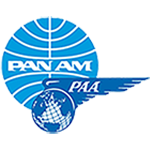June 1935
"The Next Leg of the Transpacific Journey"
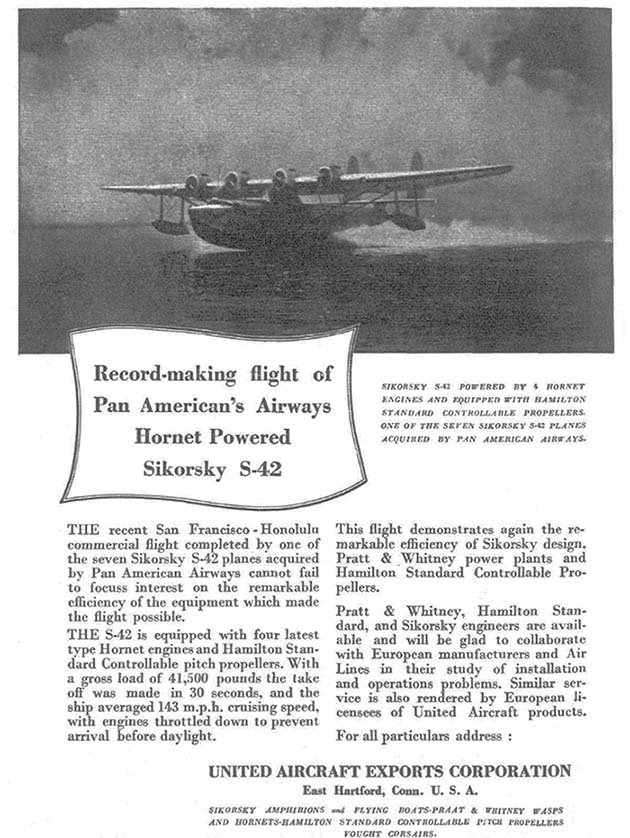
United Aircraft Corp. Ad, May 1935 (PAHF Collection).
Sand Island, Midway Atoll
In April 1935 Pan Am construction crews arrived by sea at Midway Atoll and began developing a vital refueling base at there. They built a barge in a lagoon where Pan Am flying boats could moor after landing. On June 15th S-42 (NC-823M) “Pan American Clipper” arrived at Midway on its second survey flight from California and Hawaii. Once again, Capt. Ed Musick flew with the same trusted crew he’d relied on for the first survey to Honolulu in April.
Second Survey Flight - California to Midway*
Heading West
Alameda-Pear1 Harbor. June 12-13, 1935. 2,136 mi.
Pearl Harbor-Midway. June 15, 1935. 1,181 mi.
Return Fight to the Mainland
Midway- Pearl Harbor June 17, 1935. 1,143 mi.
Pearl Harbor - Alameda June 21-22, 1935. 2,146 mi.
Setting Up Camp on Midway
“The first laundry for PAA personnel was a 55 gallon drum, powered by elbow grease… The first airport office, a wall tent.” (Stan Cohen, Wings to the Orient, p. 106).
Arriving at Midway aboard the freighter SS North Haven was a group of about 90 people including Pan Am personnel and a large construction crew. The ship’s cargo was unloaded onto barges, sometimes in heavy swells. It consisted of building materials, tractors and infrastructure for the Midway base, plus enough food & supplies for the workers for several months. The cargo also included thousands of gallons of fuel for the upcoming S-42 survey flights.
The 45-day Schedule
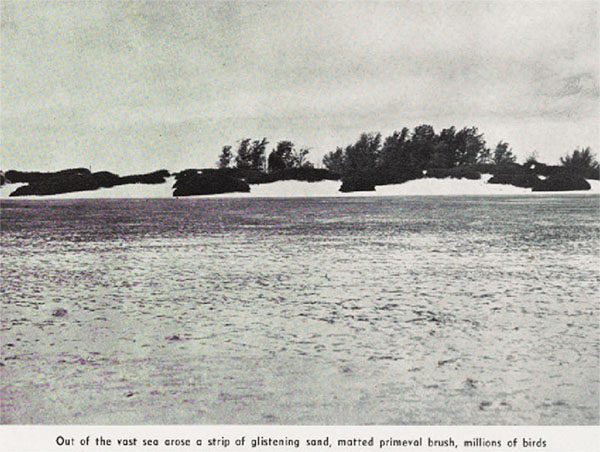
Photo: Out of the vast sea arose a strip of glistening sand, matted primeval brush, millions of birds. (Pan American Air Ways Supplement 1, 1935, University of Miami Special Collections).
“The first electric lights on Midway turned on 5:05 pm.” (Karl Lueder report, Tues., April 16, 1935).
At the very start they cut paths in the sand, pitched tents for cover, bathed in the lagoon and got a diesel generator into operation right away. After each long day of work the Pan Am crews sat down to a supper prepared by Chinese cooks, sometimes followed by movies. They invited personnel from the adjacent transpacific cable company to join them in their outdoor “theater.”
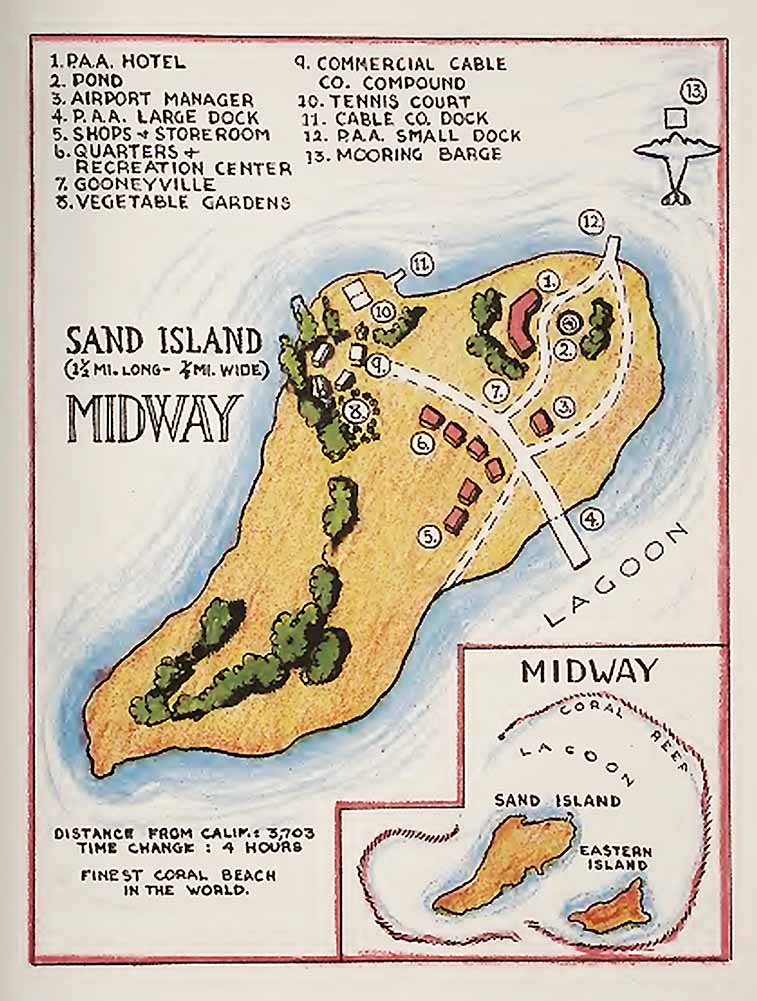
A 1939 Illustration of Pan Am's completed Midway Base by Carol Nay, in "Timmy Rides the China Clipper," (Albert Whitman) p. 39.
In the beginning the buildings and infrastructure were set up in record time, 45 days, under the leadership of Karl Lueder Airport Manager and Pan Am chief administrative officer. By May 1st, after two weeks of the North Haven’s supportive presence close to shore with heaviest work completed on the island, Lueder noted in his handwritten daily log that the ship was departing Midway. With assigned supplies, food, and construction workers, it headed 1100 miles west to Wake Island, to build another vital fuel stop.
The ship left behind a greatly reduced but highly motivated group of workers who would be responsible for completing the initial phase of the Midway base on their own — ahead of schedule!
“Remaining on Midway when the North Haven departed were eleven Pan Am personnel, a construction force of 24 individuals, and personnel assigned to the Commercial Pacific Cable Company…” (John Johnson, Jr., Airpost Journal, April 1985, p. 221 ).
Painting, Screening, Roofing, Porches, Moorings, Gutters, Cleanup, Grading...
Each day, Lueder took great care to tally the man-hours spent on construction: prefab frameworks for staff quarters, and service buildings for refrigeration and radio transmission, weather reports and upper air reading.
There were solar heaters installed, a direction-finding system and a water system to be assembled — a windmill and tank for collection of rain water (and later desalinization), a powerhouse, and a station to be made for aviation fuel storage.
Eventually there would also be a kitchen unit where a capable Chinese crew cooked, baked, and prepared meals for the workers.An area for the camp laundry was also completed.
The Second Survey Flight Arrival
By the time Ed Musick and the Pan American Clipper survey flight arrived on the atoll from Honolulu, some of Midway’s dunes had been leveled by tractors. In their place, there were numbers of buildings going up, creating a more functional compound for PAA’s operations.
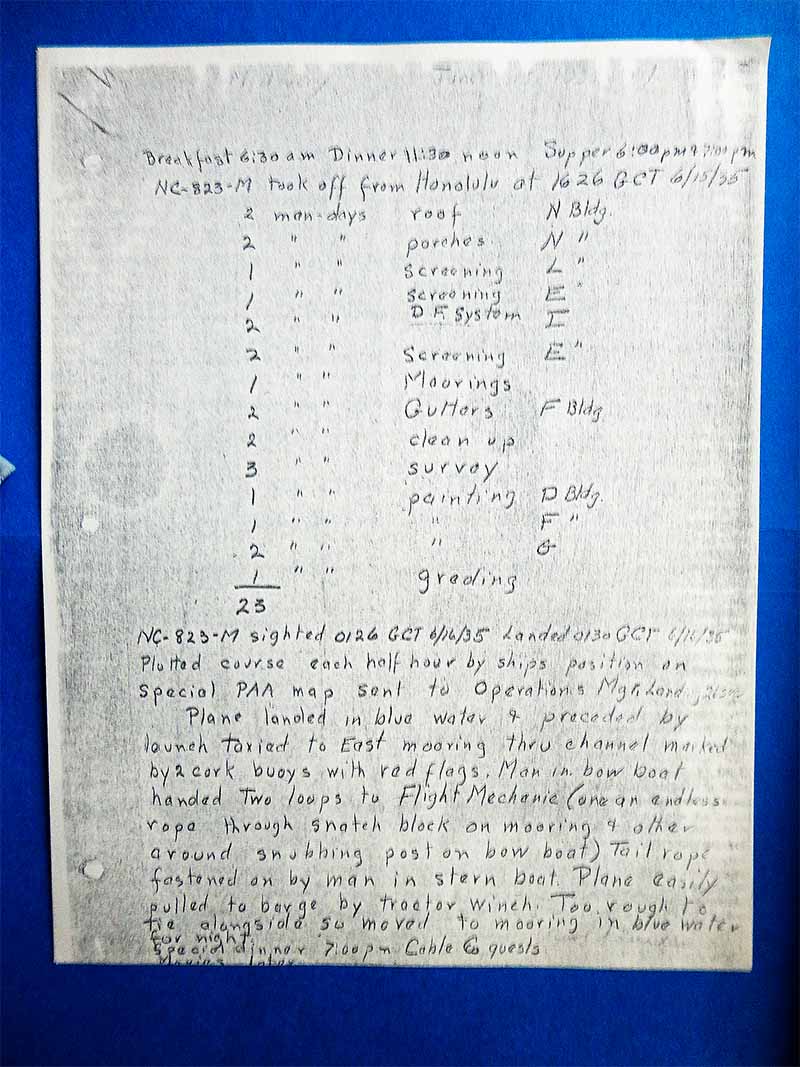
Midway: Hand-written page from Karl Lueder's log on the arrival of the second Pacific survey flight June 15, 1935 (Pan Am Historical Foundation photo).
“NC-823M sighted 0126 6/16/35.[1:26 PM on June 15th Midway time, midway around the world from Greenwich mean time] Landed 0130 GCT 6/16/35. Plotted course each half hour by ships position on Special PAA map sent to Operations Mgr… Plane landed in blue water & preceded by launch taxied to East mooring thru channel marked by 2 cork buoys with red flags. Man in bow boat handed two loops to Flight Mechanic (one an endless rope through snatch block on mooring & other around snubbing post on bow boat). Tail rope fastened on by man in stern boat. Plane easily pulled to barge by tractor winch. Too rough to tie alongside so moved to mooring in blue water for night. Special dinner 7:00 pm Cable Co. guests,. Movies later.” (Karl Lueder’s handwritten log June 16, 1935, GCT).
Pan American Clipper Returns to the Mainland
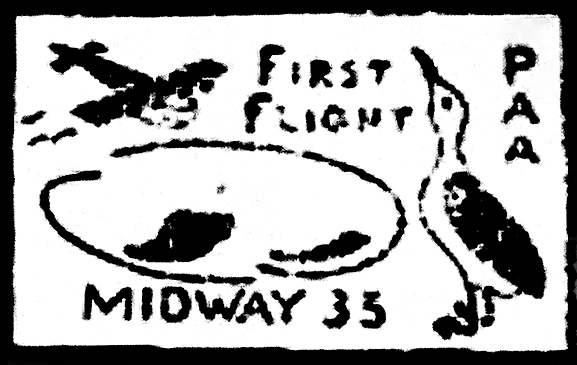
Photo of Midway cachet by Karl Lueder (PAHF Collection).
In the early hours of June 17 (breakfast at 3:00 a.m.), the crew of the S-42 prepared to leave Midway for their flight back to Honolulu and return to Alameda, CA.
A select number of airmail covers, hand-stamped from original wood cuts called cachets, were carried with company mail on the flight back. The envelopes showed a distinctive sea bird, a mapped view of Midway’s two islands, and “PAA” stamped in black from a woodcut designed by Karl Lueder himself.
It commemorated the friendly “gooney birds,” Laysan Albatross —graceful in flight but awkward on land — characteristics that led to its nickname. Today, these protected birds remain a fond symbol for Midway Atoll as well as for Pan Am’s exotic Pacific outpost during its pioneering days.
Transpacific cachets, now collectors items, marked each leg of Pan Am’s Pacific journey and the aircraft that were flown. The 90-year-old stamps are tangible artifacts of Pan Am’s astonishing history.
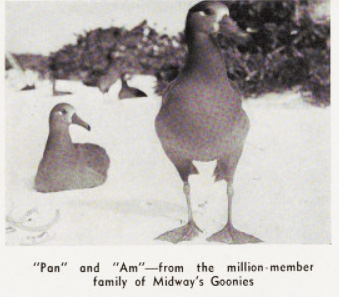
"Pan" and "Am" -- from the million-member family of Midway's Goonies (Pan American Air Ways Supplement 1, 1935, University of Miami Special Collections).
SOURCES
Karl Lueder, hand-written logs & typed reports, April 1935-June 1935, Midway Atoll (Pan Am Historical Foundation collection).
“Karl Lueder,” Citizen's Voice, Wilkes Barre, PA, 08/06/84, p. 14.
* "PAA's 1935 Pacific Survey Flights" by John Johnson, Jr. , The Airpost Journal, April 1985, Vol. 56, No. 7, pp. 220 - 221.
"Pan American Air Ways, Supplement 1", 1935 (University of Miami Special Collections). https://digitalcollections.library.miami.edu/digital/collection/asm0341/id/50150/rec/25
"Wings to the Orient: A Pictorial History" by Stan Cohen (Pictorial Histories Publishing) 1985.
